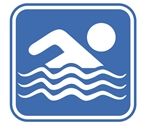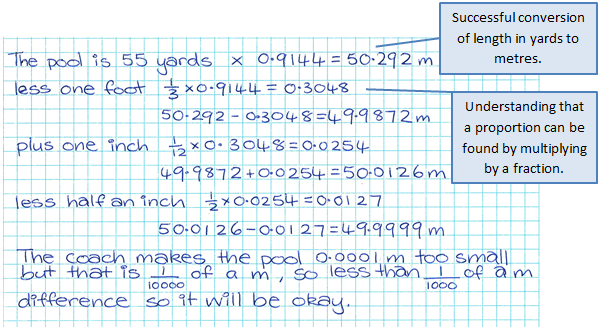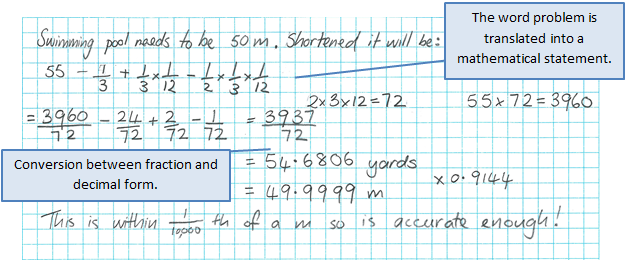Swimming lengths
The purpose of this activity is to engage students in using their knowledge of fractions and decimals, and an ability to use operations on these, to solve a problem.
This activity assumes the students have experience in the following areas:
- Converting between fractions and decimals.
- Calculating with fractions and decimals.
- Converting between metric units of length and time.
The problem is sufficiently open ended to allow the students freedom of choice in their approach. It may be scaffolded with guidance that leads to a solution, and/or the students might be given the opportunity to solve the problem independently.
The example responses at the end of the resource give an indication of the kind of response to expect from students who approach the problem in particular ways.

Task: A community swimming pool that was built before 1967 is 55 yards in length. It needs to be shortened to 50 m (accurate to the nearest 1/100 of a metre) to be able to be used for official events.
A retired swim coach has said: "55 yards, less one foot, plus one inch, less half an inch should make it right."
One inch is 1/12 of a foot and one foot is 1/3 of a yard and there are 0.9144m in one yard.
Would his suggestion be within the official requirements for 50 ± 0.01 m?
The following prompts illustrate how this activity can be structured around the phases of the Mathematics Investigation Cycle.
Make sense
Introduce the problem. Allow students time to read it and discuss in pairs or small groups.
- Do I understand all the words, or should I ask for help?
- What are the important words and symbols?
- Can I draw or sketch the situation? (Drawing a diagram of the existing pool, as a rectangle, with the parts that it needs to be reduced by, may help.)
- What information has been given and what information do I need? (Students will need to look up the conversion between yards and metres, and inches and centimetres.)
- What will an answer to the problem look like? (An answer must take a position about the coach’s claim and support the position with evidence.)
Plan approach
Discuss ideas about how to solve the problem. Emphasise that, in the planning phase, you want students to say how they would solve the problem, not to actually solve it.
- What are the maths skills I need to work this out? (Conversion between units of measure is needed.)
- What will be the best way to represent the lengths that need to be removed? (Leave them as fractions or convert each measure to centimetres or decimals of a metre.)
- What strategies can I use to get started?
- How will I record my working as I check the coach’s claim?
- Can I approach the problem systematically, so nothing is missed?
- What tools (digital or physical) could help my investigation?
Take action
Allow students time to work through their strategy and find a solution to the problem.
- Have I shown my workings in a step-by-step way?
- How can we share the mahi in our group to get the best result?
- How can we stay connected?
- Does the claim seem correct? How does my working support or refute the claim?
- Is there another possible answer or way to calculate the new length in an efficient way?
Convince yourself and others
Allow students time to check their answers and then either have them pair share with other groups or ask for volunteers to share their solution with the class.
- What is the solution? Does the coach’s claim stack up?
- Show and explain how you worked out your solution.
- Can others see how I worked it out?
- How do I know if I have worked this out correctly?
- Which ideas or tools worked well in my investigation?
- Is there some mathematics that I would like to learn?
- Which ideas would convince others that my findings answer the investigation question?
Examples of work
Work sample 1
The student calculates, with guidance, the original length and the adjustment recommended, in metres, to solve a problem.
Click on the image to enlarge it. Click again to close.
Work sample 2
The student calculates the original length and the adjustment recommended, in metres, to solve a problem.

